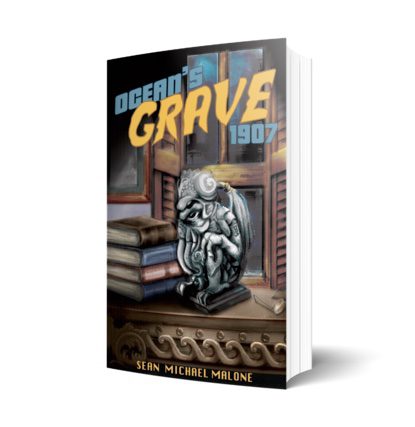Review by Jenna Zerbel | Ten16 Press


Ocean’s Grave represents Malone’s second novel in his series of Lovecraftian Horror, a continuation of themes and characters from his first release, Spring City Terror 1903. While not a direct a sequel, Grave rewards readers of the previous entry with efficient worldbuilding and allusions. At the same time, one gets the impression that each book of the series can still be comprehended and enjoyed as standalone reads.
The plot involves an antiquities merchant, Mitchell Bernheim, practicing his trade in the dusty aftermath of the Great San Francisco Earthquake of 1906. The setting reflects the persistent aura of misery and hardship while also the restless spirit of the great city’s citizenry. There’s a robust yet manageable set of characters: hostile businessmen, gangsters, love interests, academics, and cult members — the full casting call of Lovecraftian fare. While in the end, they amount to an assortment of allies and enemies, their introduction is rooted in a sense of realism that does not establish a plot progression too transparent or predictable.
Through a misfortunate turn, Mitchell takes possession of a cursed artifact — a Chinese tomb guardian, supposedly of the medieval Tang Dynasty (618-907 CE). This comes to dictate the action more than just its immediate effects on the protagonist; two-thirds through the book, the setting pivots to China. By this point, it has become apparent that Malone has taken every advantage of the globe-trotting nature that has increasingly come to define Lovecraftian tales of larger scale. One can deduce that he is incorporating various elements of his academic background in history with the playful alignment of destiny. The end result, far from being distracting or unbelievable, renders a distinct signature to the work.
The book explores the various complications that the tomb guardian poses, both in who also claims ownership over it, as well as the innate curse and foul dreams that it radiates to its owner. Without giving too much away, the tomb guardian is not without beneficial effects either — allowing Mitchell to continue with his deeper investigation into the artifact where others may have succumbed to death or madness.
This review agrees with the assessment of Dr. Ian DeJong, who describes Ocean’s Grave as “terrifying and strangely gripping – hard to put down, as its colorful cast of rounded characters encounters organized crime, reincarnation, and unnameable forces wrestling for universal control.”
In summary, Ocean’s Grave is a nuanced and welcome addition to Malone’s growing canon, and the expansive library of Lovecraftian fiction. Perhaps Malone’s greatest success is the construction of plot structures that do not overwhelm new readers of the Cthulhu Mythos, while also bearing all of the more subtle elements genre veterans come to appreciate. In every respect, the story ripples begun in Spring City Terror have amplified their reach to a wider setting and deeper level of immersion in the mystery and horror of Lovecraft.

About the Book
Ocean’s Grave 1907
In the Paris of the West, antique specialist Mitchell Bernheim is haunted by life after death – his own.
As San Francisco recovers from the great earthquake, Mitchell obtains a bizarre Chinese tomb guardian at auction. He quickly discovers that the artifact’s suspicious origins make it highly prized by criminals and occultists, its price much greater than he had originally bargained for.
Coming into contact with impossible sorcery, entangled myths of a bloodstained dynasty, formidable foes and allies.
